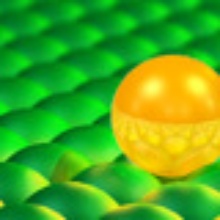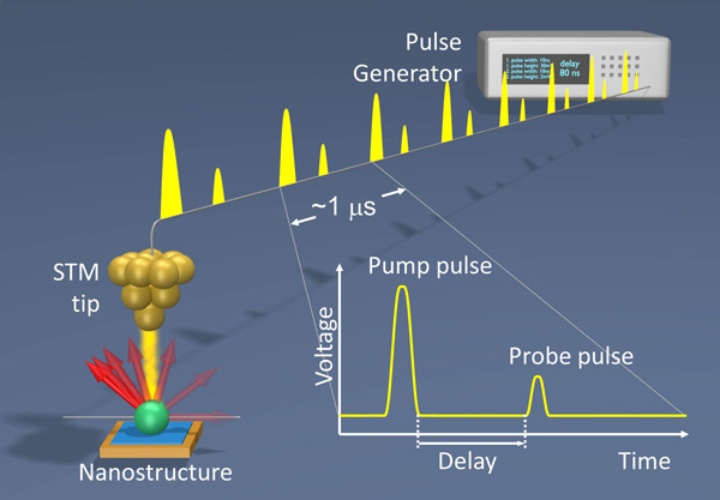Dynamics at the atomic scale
In our research we aim to resolve individual quanta of excitations, for example the flipping the spin of just one electron. Microscopy at this level requires extremely high resolution in energy, space and time.
This presents a major experimental challenge because techniques that offer high spatial resolution and methods that have high temporal resolution have developed largely orthogonal to each other. Transmission electron microscopy or scanning probe microscopy routinely reach atomic spatial resolution but acquiring an image can take seconds or minutes. By contrast, ultrafast pump-probe spectroscopy using femtosecond lasers or recently also free-electron lasers achieve femtosecond temporal resolution but are often ensemble-averaging over micrometers of millimeters of sample material.
Ultrafast Scanning Tunneling Microscopy
We use custom-designed scanning tunneling microscopes, STM, that can employ ultrafast pump-probe measurement methods. The tip of the STM addresses individual atoms on a surface and ultrafast excitation of the tunnel junction can trigger dynamics at the point of the STM. Time-delayed weaker pulses measure the subsequent variations in the tunneling probability of electrons.
Tunneling electrons can scatter inelastically with the atoms of the sample and thus create charge, spin or vibration excitations and our STM-based pump-probe spectroscopy can record the dynamical evolution of these excitations. We employ different pump-probe excitation methods tailored to the needs of the specific experiment. In particular, we use an all-electronic pump-probe scheme to study the nanosecond-fast magnetization dynamics of few-atom quantum spin systems and an optical pump-probe scheme using THz light to study the femtosecond-fast dynamics of charge excitations.
In this measurement scheme a strong voltage pulse (the pump pulse) applied to the probe tip locally excites a structure. The resultant dynamics are monitored by a time-delayed weaker voltage pulse (the probe pulse). The time resolution that can be achieved for repetitive processes is determined solely by the precision of the voltage pulses and can greatly exceed the bandwidth of the high-gain current amplifiers that detect the tunnel current in an STM. We employ pulse-shaping to compensate dispersion and spurious reflections of the high-frequency transmission line that delivers the pulses to the STM tip and achieve sub-nanosecond time resolution while maintaining micro-electronvolt energy selectivity. This method is ideally suited to experiments on the fragile spin excitations of magnetic atoms.
In this measurement scheme we deliver femtosecond-fast electric field pulses directly to the STM tip via free-space optics and thus remove dispersion that would occur in transmission lines. We make use of Terahertz light pulses because they can efficiently couple to the STM tip and induce ultrafast voltage transients at femtosecond speed. The THz pulses are generated by optical rectification of near-infrared light pulses and fed to the STM. Field-enhancement at the STM tip produces peal field strengths in the MV/cm range which are capable of inducing non-linear effects. Analogous to conventional optical pump-probe spectroscopy, a first strong THz pulse induces ultrafast excitations of the electrons in the sample and a time-delayed weaker THz pulse probes the subsequent dynamical evolution of the system.
Funding
See our publications for a full list of references.
Contact

Sebastian Loth
Prof. Dr.Head of Institute FMQ1 (managing director)



